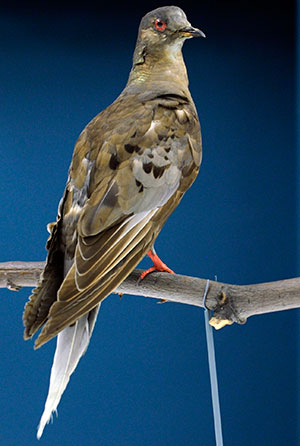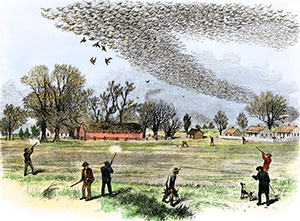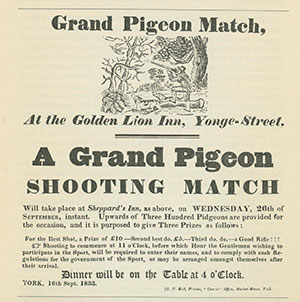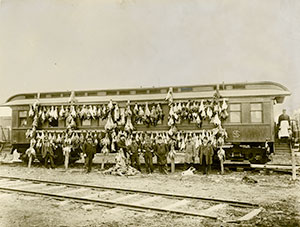The extinction of the passenger pigeon
Simply sign up to the Life & Arts myFT Digest -- delivered directly to your inbox.
The late summer of 1914 was not the ideal moment in history to get the world worked up over the death of a pigeon in Cincinnati Zoo. However, the news about Martha did get space in some of the American newspapers.
One of them, The Evening World in New York, even made a comparison with the conflagration that had just begun across the Atlantic, saying Martha’s death should be noted even when “the last European soldier known to war lords is in danger of dying in his turn”.
Indeed, looking back a century later, one might argue – taking a very, very long view – that Martha’s death was more consequential than the first world war. For that did not turn out to be the war to end all wars. But Martha was undoubtedly the passenger pigeon to end all passenger pigeons.

Her cagemate George had died five years earlier; the marriage was chickless; all the other captive passenger pigeons had died; none had been seen in the wild for a long time. Ectopistes migratorius was now extinct.
No one knows when the last great auk died. Or the last dodo. But the last passenger pigeon’s death can be dated more or less exactly: the afternoon of September 1 1914. There was something else extraordinary about this extinction. This was not some marginal species, retiring from trying to eke out an existence on a remote island or a lonely mountainside. When the white man arrived in North America, this was almost certainly the most common bird on the continent, quite possibly the most common in the world.
Some calculations suggest there were 3bn to 5bn. Others suggest there could have been up to 3bn in a single flock. This is like the extinction of the house fly. Or of grass. Or, perhaps, of the galumphing, domineering, myopic two-legged mammal whose presence did for the passenger pigeon. As the title of a centenary exhibition at the Smithsonian in Washington has it, Once There Were Billions. And then there were none.
…
The passenger pigeon was a touch larger than the still-familiar feral pigeon. Early American naturalists covered the spectrum trying to describe the colours of the male plumage, identifying shades of blue, emerald green, gold, orange, crimson, copper and coral. Words like “iridescent” and “opalescent” crop up. “Oh, what bonny, bonny birds!” enthused the Scotsman John Muir. “A bird of transcendent beauty,” said Rev EC Dixon.
But it was a little hard for the average American pioneer to focus on the individuals: individuality was not these birds’ strong point. Except when roosting or nesting, they were nomadic, travelling in numbers that made herds of wildebeest look reclusive. Major Ross King in Ontario saw a flock he estimated at 300 miles long and a mile wide, “not hovering about but darting onwards in a straight line with arrowy flight”.
Travelling in Kentucky in 1813, John Audubon talked of the pigeons passing overhead for three full days: “The light of noonday was obscured as by an eclipse; the dung fell in spots, not unlike melting flakes of snow; and the continued buzz of wings had a tendency to lull my senses to repose.”
That was all very well for Audubon, who made his still-transcendent reputation by shooting birds and painting them. It was not wholly bad news for most Kentuckians, who could dine all week on pigeon pie. However, Errol Fuller, author of The Passenger Pigeon, one of a clutch of books that mark Martha’s centenary, tried to recreate the experience of a farming family. Imagine, he says, if you were eking out a living from acres hewn from the wilderness by your own sweat, when one fine spring morning a flock of millions decides this looks like a nice place to roost. The only recourse is to rush indoors, as if fleeing a storm.
“Three or four days pass. Then, as suddenly as they came the pigeons are gone . . . The growing crops are destroyed, the buds are eaten or trampled, the orchards wrecked . . . There will be little to feed the family and nothing to sell . . . Nor there will be anything left for the livestock . . . The well is fouled . . . The damage the birds have wrought can hardly be measured.”
These days, a comparison might be a motorbike gang crashing a 10-year-old’s birthday party. It is a scene that must have been re-enacted many times across the birds’ range, the eastern half of the US and Canada, until the late 19th century. One Bishop of Montreal excommunicated the passenger pigeon as punishment.
Audubon has a dramatic description of a roost: “The pigeons, arriving by thousands, alighted everywhere, one above another, until solid masses as large as hogsheads were formed on the branches all round. Here and there the perches gave way under the weight with a crash and, falling to the ground, destroyed hundreds of the birds beneath . . . It was a scene of uproar and confusion.” When the survivors departed, the carrion eaters arrived for the pickings. But none of the contemporary writers seem able to convey the smell or even the sound. “A hard storm at sea,” suggests Fuller.
Thousand, millions, billions. But, in 1856, the French traveller and writer Bénédict-Henry Révoil made a startling prediction: “Everything leads to the belief that the pigeons, which cannot endure isolation, and are forced to flee or to change their way of living according to the rate at which North America is populated by the European inflow, will simply end by disappearing.” A year later a committee of the Ohio senate looked into the matter. “The passenger pigeon needs no protection . . . No ordinary destruction can lessen them,” it concluded.

In a strange way, the politicians were not wrong. It was not ordinary destruction that killed Martha and her kind. The Indians with nets had no effect on their numbers; nor, for the most part, did the white men with shotguns; nor the hawks and coyotes who feasted at the margins of their turbulent bird megalopolises. The damage was done by the innocent God-fearing farmers, hacking down what they called wilderness, which we would now call virgin forest.
The raids on farms may have been an early warning of distress: the passenger pigeon’s food of choice was not an infant cornfield but “mast”: the nuts of the beech, oak and, to a lesser extent, chestnut trees that once covered the landscape. Ohio was 95 per cent forest when the white settlers moved in, 54 per cent by 1853, 10 per cent by 1900. By then Martha’s death could be foretold, even by an Ohio state senator.
It was towards the end that American insouciance towards mass slaughter made its contribution. The last great nestings, though far smaller than in Audubon’s day, were now even more of a fiesta for gunmen, business being on a much greater scale. The pigeons were meat; their oils and fat produced a kind of ersatz butter; 50 birds were said to make a feather pillow. As late as 1883 a dealer in Wisconsin sent 2m of them to market.
But sightings grew rarer and rarer, and the evidence for them ever flakier. Joel Greenberg, in another recent book, A Feathered River Across the Sky, says the last well-attested sighting of a wild passenger pigeon was by a young man in Indiana in 1902. Naturally, he shot it.
…
Study of the passenger pigeon has been curtailed for the past hundred years, owing to the absence of live specimens. However, research published in June, by mainly Taiwanese researchers, used genomic and ecological analysis to suggest that passenger pigeon numbers (until 1914) were never stable and that it was not consistently as superabundant as the anecdotal evidence suggests.
The population was prone to dramatic rises and falls, perhaps depending on the cyclical beechnut and acorn crops. “For the passenger pigeon, it was always either boom or bust,” in the words of Stuart Pimm, professor of conservation at Duke University. It was thus akin to “an outbreak species”, of which the classic example is the locust.
This is very interesting: the only known American extinction on a similar scale is that of the Rocky Mountain grasshopper, aka the locust. In 1874, so Kieran Suckling of the Arizona-based Center for Biological Diversity told me, about a trillion of them formed an 1,800-mile long, 110-mile phalanx and created agricultural havoc from southern Canada to Texas. Some sources say there were 12tn. There is no dispute about the current number. “No other animal on the planet has been estimated to be so numerous,” says Suckling. “By 1902, it was extinct. North America and Antarctica are now the only locust-free continents on Earth.” No wonder so many rural Americans believe in the power of prayer.

There is a more Darwinian explanation. It emerged later that the grasshopper’s logistical chain was stretched a little thin. It bred only in a couple of sandy river valleys, which by 1902 had been developed.
What emerges from these two simultaneous stories is that the safety-in-numbers strategy pursued by these species was successful until humans changed the environment. “The positive trait can then swiftly become a liability,” explains Suckling. “If the species is reduced in number by external pressure, then it has an internal problem because its very mode of existence requires very large numbers to work.”
The passenger pigeon did not only go in for orgies of destruction; it went in for a kind of group sex. The largest known nesting colony, in Wisconsin, measured 850 square miles. This air force expected to take heavy losses and depended on being able to wander at will. “The plain truth,” writes Fuller, “is that the lives of passenger pigeons and technological humankind were incompatible.”
…
“The Sixth Extinction” is the phrase sometimes used to describe the flora and fauna that have disappeared in the past five centuries, including at least 190 known birds, many of them from the columbidae family, kinsmen to their once-fecund American cousin.
Among these were the Liverpool pigeon (more exotic than it sounds) and the extravagantly handsome Solomons crested pigeon, thought to have been a single egg-laying flightless bird that was unsurprisingly wiped out when the domestic cat showed up. “The naive species go first,” says Suckling. “The habitat specialists are next to go, and they may go very quickly.” Even if anyone had listened to the French pessimist Révoil in 1856, the process may already have been irrevocable. The conquest and settlement of North America and Australasia came at a time when naturalists could observe the process but not grasp the consequences. The human casualties were given short shrift too.

Today the main pressure points are elsewhere, in places of still half-explored biological richness such as Madagascar, Brazil and New Guinea, and in the oceans. In May, Prof Pimm co-authored a study in the journal Science saying that extinctions were now running at 1,000 times the natural rate. The loss of habitat is being compounded by climate change: species can only adapt by heading somewhere cooler if they have sufficient room for manoeuvre. He insists he is not apocalyptic. “People call me up as an expert on extinction. I want them to call me as an expert in preventing extinctions.” Pimm runs a small charity, Saving Species, specialising in restoring degraded land.
But he would have needed to restore a degraded continent to save the passenger pigeon. One group of American scientists is claiming it can render the bird de-extinct by using the DNA of a closely-related but still extant pigeon. Critics call it a publicity stunt. And even it were genetically feasible, there would be the small problem of removing a couple of hundred million humans from the birds’ old stamping grounds.
The Evening World newspaper, which had put Martha’s death in the context of war, would definitely have been against a restoration. Its report concluded by recalling the destruction the birds wrought and wished them good riddance. “Therefore, while we may lament in sentiment the passing of the last passenger pigeon, we have good cause to rejoice that nature did not fit him to adapt to civilisation and stay with us like the grasshopper.” Funny the grasshopper should crop up again. Those trillions did not stay with us either. If we have learnt anything in the past hundred years it is that humanity is ill-equipped to pick and choose its companions on the planet.
After her death, Martha’s body was immediately encased in ice and despatched to the Smithsonian in Washington by fast train. Long forgotten in the vaults, it has been restored to public display at the National Museum of Natural History for the centenary. Stuffed. Cincinnati Zoo has renovated its memorial to Martha and will re-dedicate it on September 1. But it is hard to find details of the ceremony on the zoo’s website. It prefers to focus on its successes.
More information at savingspecies.org; biologicaldiversity.org
Matthew Engel is an FT columnist
Photographs: AP; Alamy; ‘The Passenger Pigeon’ by Errol Fuller (Princeton); William B Mershon Family Collection/Public Libraries of Saginaw
Slideshow photographs from ‘The Passenger Pigeon’ by Errol Fuller, published next month by Princeton University Press. The book includes rare photographs of the last passenger pigeons kept by the zoologist Charles Whitman.
Comments